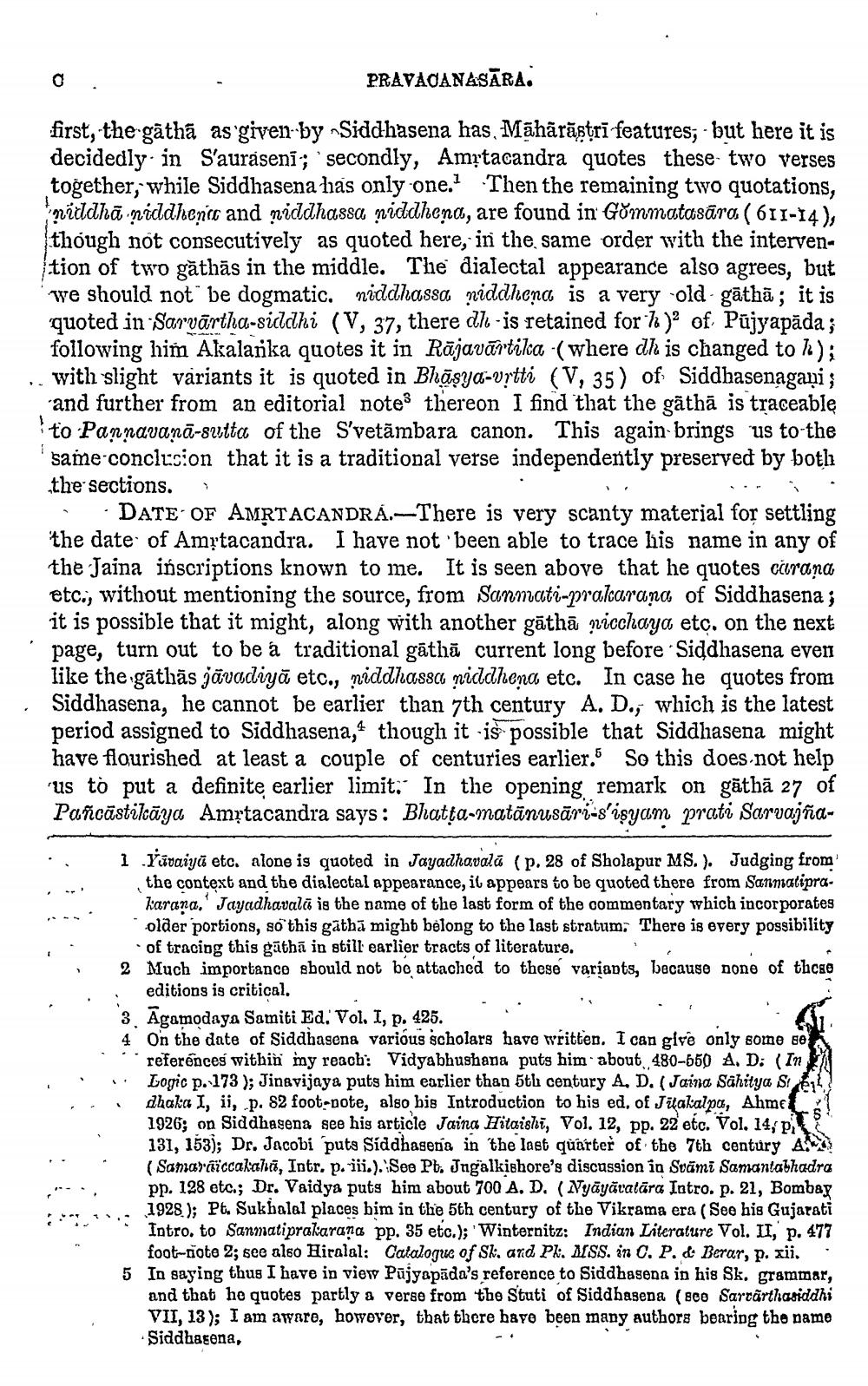________________
PRAVACANASĀRA.
first, the gâtha asgiven-by-Siddhasena has, Māhārāstrī features;- but here it is decidedly. in Sauraseni; 'secondly, Amịtacandra quotes these two verses together, while Siddhasena lias only one. Then the remaining two quotations, riddhā niddhenao and niddhassu niddhena, are found in Gõmmatasāra (611-14), though not consecutively as quoted here, in the same order with the intervention of two găthās in the middle. The dialectal appearance also agrees, but we should not be dogmatic. niddhassa niddhena is a very old gāthā; it is quoted in Sarvārtha-sicldhi (V, 37, there ah-is retained for 2) of Pūjyapāda; following his Akalanka quotes it in Rājavārtika (where dh is changed to R); with slight variants it is quoted in Bhāsya-vytti (V, 35) of Siddhasenagani; and further from an editorial notes thereon I find that the gathā is traceable to Pannavanā-sutta of the S'vetāmbara canon. This again brings us to the same conclusion that it is a traditional verse independently preserved by both the sections.
. . DATE OF AMRTACANDRÁ-There is very scanty material for settling the date of Amytacandra. I have not been able to trace his name in any of the Jaina ińscriptions known to me. It is seen above that he quotes carana etc., without mentioning the source, from Sanmati-pralarana of Siddhasena; it is possible that it might, along with another gāthā ricchaya etc. on the next page, turn out to be a traditional gāthī current long before Siddhasena even like the.gāthās jāvadiyā etc., niddhassa niddhena etc. In case he quotes from Siddhasena, he cannot be earlier than 7th century A. D., which is the latest period assigned to Siddhasena,- though it is possible that Siddhasena might have flourished at least a couple of centuries earlier. So this does not help us to put a definite earlier limit. In the opening remark on gãthā 27 of Pañcāstilcāya Amrtacandra says: Bhatta-matānusāri-s'isyam prati Sarvajña
19
:
:
1 Yūtaiyö etc. alone is quoted in Jayadhavalá (p. 28 of Sholapur MS. }. Judging from , the context and the dialectal appearance, it appears to be quoted there from Sanmatiprakarana.' Jayadhavala is the name of the last form of the commentary which incorporates older portions, so this gathā might belong to the last stratum. There is every possibility
of tracing this gātha in still earlier tracts of literature. 2 Much importance should not be attached to these variants, because none of thcae
editions is critical. 3. Agamodaya Samiti Ed. Vol. I, p. 425. 4 On the date of Siddhagena various scholars have written. I can give only some se
references within my reach: Vidyabhushana puts him about 480-650 A. D: (In Logic p. 173 ); Jingvijaya puts him earlier than 5th century A, D. (Jaina Sahitya Sie dhaka I, ii, p. 82 foot-pote, also bis Introduction to his ed. of Jitakalpa, Ahmet 1926; on Siddhagena see his article Jaina Hitaishi, Vol. 12, pp. 22 etc. Vol. 14, pit 131, 153); Dr. Jacobi puts Siddhasería in the last quarter of the 7th century A. (Samaraiccakahi, Intr. p. iii.). See Pb. Jagalkishore's discussion in Svāmi Samantabhadra pp. 128 etc.; Dr. Vaidya puts him about 700 A. D. (Nyāyāuatāra Intro. p. 21, Bombay 1928); Pt. Sukhalal places him in the 5th century of the Vikrama era (See his Gujarati Intro to Sanmatiprakarana pp. 35 etc.); 'Winternitz: Indian Literature Vol. II, p. 477
foot-note 2; see also Hiralal: Catalogue of Sk. and Pl. MSS. in C. P. d Berar, p. xii. . 5 In saying thus I have in view Pūjyapāda's reference to Siddhasena in his Sk. grammar,
and that he quotes partly & verse from the Stuti of Siddhasena (800 Sartärthasiddhi VII, 13); I am aware, however, that there have been many authors bearing the name Siddhasena,




